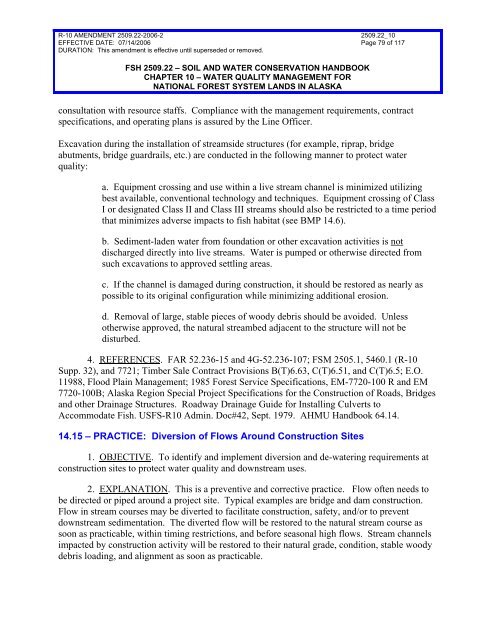Transportation & Other Facilities Management - USDA Forest Service
Transportation & Other Facilities Management - USDA Forest Service
Transportation & Other Facilities Management - USDA Forest Service
Create successful ePaper yourself
Turn your PDF publications into a flip-book with our unique Google optimized e-Paper software.
R-10 AMENDMENT 2509.22-2006-2<br />
EFFECTIVE DATE: 07/14/2006<br />
DURATION: This amendment is effective until superseded or removed.<br />
FSH 2509.22 – SOIL AND WATER CONSERVATION HANDBOOK<br />
CHAPTER 10 – WATER QUALITY MANAGEMENT FOR<br />
NATIONAL FOREST SYSTEM LANDS IN ALASKA<br />
2509.22_10<br />
Page 79 of 117<br />
consultation with resource staffs. Compliance with the management requirements, contract<br />
specifications, and operating plans is assured by the Line Officer.<br />
Excavation during the installation of streamside structures (for example, riprap, bridge<br />
abutments, bridge guardrails, etc.) are conducted in the following manner to protect water<br />
quality:<br />
a. Equipment crossing and use within a live stream channel is minimized utilizing<br />
best available, conventional technology and techniques. Equipment crossing of Class<br />
I or designated Class II and Class III streams should also be restricted to a time period<br />
that minimizes adverse impacts to fish habitat (see BMP 14.6).<br />
b. Sediment-laden water from foundation or other excavation activities is not<br />
discharged directly into live streams. Water is pumped or otherwise directed from<br />
such excavations to approved settling areas.<br />
c. If the channel is damaged during construction, it should be restored as nearly as<br />
possible to its original configuration while minimizing additional erosion.<br />
d. Removal of large, stable pieces of woody debris should be avoided. Unless<br />
otherwise approved, the natural streambed adjacent to the structure will not be<br />
disturbed.<br />
4. REFERENCES. FAR 52.236-15 and 4G-52.236-107; FSM 2505.1, 5460.1 (R-10<br />
Supp. 32), and 7721; Timber Sale Contract Provisions B(T)6.63, C(T)6.51, and C(T)6.5; E.O.<br />
11988, Flood Plain <strong>Management</strong>; 1985 <strong>Forest</strong> <strong>Service</strong> Specifications, EM-7720-100 R and EM<br />
7720-100B; Alaska Region Special Project Specifications for the Construction of Roads, Bridges<br />
and other Drainage Structures. Roadway Drainage Guide for Installing Culverts to<br />
Accommodate Fish. USFS-R10 Admin. Doc#42, Sept. 1979. AHMU Handbook 64.14.<br />
14.15 – PRACTICE: Diversion of Flows Around Construction Sites<br />
1. OBJECTIVE. To identify and implement diversion and de-watering requirements at<br />
construction sites to protect water quality and downstream uses.<br />
2. EXPLANATION. This is a preventive and corrective practice. Flow often needs to<br />
be directed or piped around a project site. Typical examples are bridge and dam construction.<br />
Flow in stream courses may be diverted to facilitate construction, safety, and/or to prevent<br />
downstream sedimentation. The diverted flow will be restored to the natural stream course as<br />
soon as practicable, within timing restrictions, and before seasonal high flows. Stream channels<br />
impacted by construction activity will be restored to their natural grade, condition, stable woody<br />
debris loading, and alignment as soon as practicable.

















